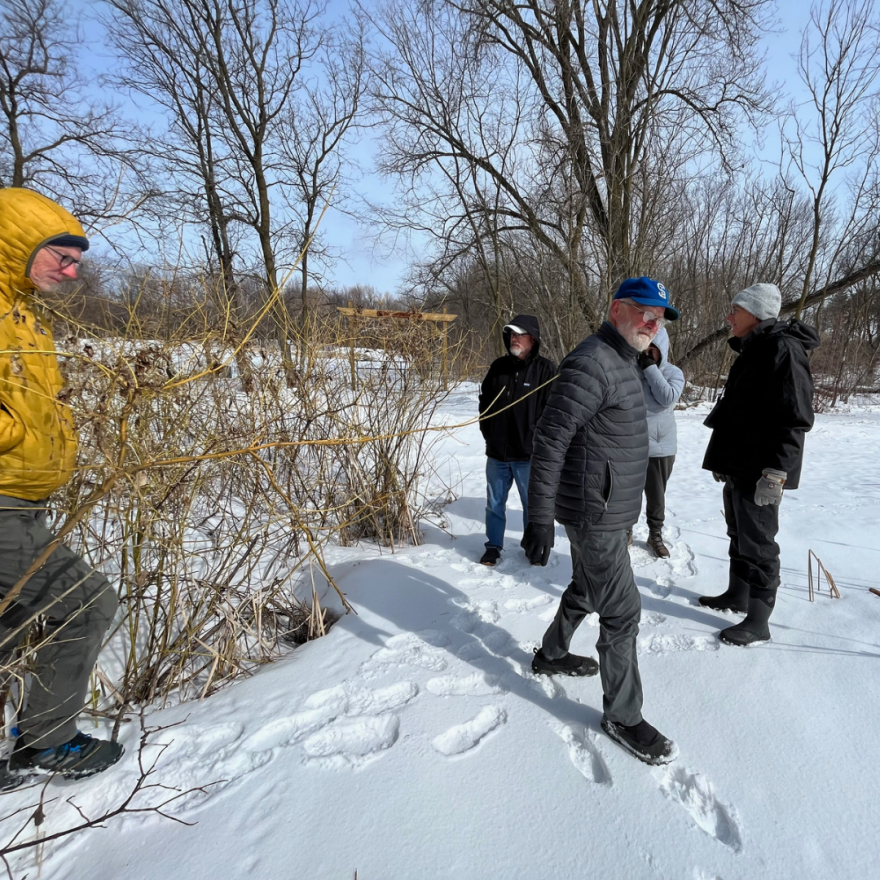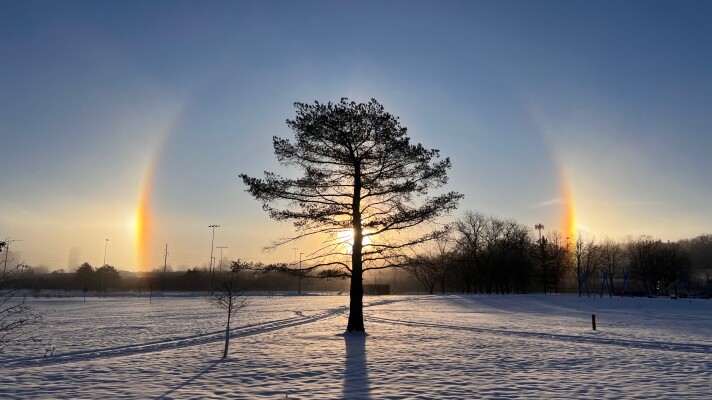It’s another great week for phenology! This week’s observations include a mystery shriek in the woods, frozen vole tunnels and a rare Golden Eagle sighting.
Remember you can add your voice to this list! Get in touch with me (smitchell@kaxe.org), John Latimer (jlatimer@kaxe.org) or text "phenology" to 218-326-1234.
For more phenology, subscribe to our Season Watch Newsletter or visit the Season Watch Facebook page.
Phenology in the Classroom Workshop in West St. Paul

Jen and Dave reported from “Mr. Latimer’s 40th grade class at Dodge Nature Center in West St. Paul.” It was a lovely day for a phenology workshop, despite cold weather that stopped the sap run. We strolled across thick lake ice and observed animal tracks (including a mink), fuzzy pussywillow buds, and lots of maple and ash trees. Two Canada Geese perched on top of a silo, displaying the first territorial mating behavior of the season. We also sampled some truly disgusting highbush cranberries: I wouldn’t recommend them.
“Hang in there,” Jen and Dave concluded. “Spring is almost here!”
“It’s almost here somewhere: maybe in Des Moines, I’m not sure,” replies John. “We’ll let you know when it arrives here, if you don’t let us know first.”
Eagle View Elementary in Pequot Lakes

Bethie and Alexa reported from Deanne Trottier's class at Eagle View Elementary in Pequot Lakes. They had an icy, muddy and snowy day for their phenology walk, with snow piled so deep around the school that it looked like “expired mashed potatoes!”
The class saw two Trumpeter Swans, chickadees, crows, and gray and black squirrels. The students were delighted to discover frozen tunnels in the snow. The tunnels were constructed by voles and branched out in many directions from the birdfeeder: clearly an important food source for the rodents. “Reporting from Pequot Lakes: Think spring!”
“Indeed, keep thinking spring,” John responds. He’s happy to hear about the frozen vole tunnels, and remarks he saw hundreds of swans on his drive to the Twin Cities last weekend. Every bit of open water had a pair or two of swans on it — quite a testament to Minnesota’s impressive swan population.
Long Lake Conservation Center near Palisade

Maddy and Elliot reported from Battle Lake's trip to Long Lake Conservation Center:
“After having our trip rescheduled because of a snowstorm we made it to Long Lake Conservation Center March 15th to March 17th just in time for a snowstorm. The maple sap is not running yet. In 2022 sap started running at Long Lake on March 25. It should be pretty close to that this year.
“Despite the snow, we saw two Garter Snakes in the snow. We think they’re as ready for spring as we are. A lot of Bald Eagles have moved into the area, and in most cases were spotted in pairs. Long Lake’s chef said that the pair at her house are already in the nest.
“Our group spotted the first Robin of the season. The Long Lake staff said that this Robin is a migratory bird, because none have been spotted on campus all winter. Last year, the first Robin at Long Lake was spotted on March 18.
“Dill Prickles the porcupine was high up on a skinny branch of a red oak on campus taking a ‘grandpa nap.’ We also got to see him shake the snow off himself from up in the tree. Very cute.
“Two Long Lake naturalists jumped into Long Lake on Tuesday to make a fun video about summer camp. We got to check out the hole in the lake and saw small sunfish and perch and a few bullheads. There were HUNDREDS of minnows coming to the surface checking it out; enjoying the light. The naturalists said the minnows are northern red-bellied dace. The ice depth was 18 inches.
“A Chipmunk was at the bird feeder, and we saw Blue Jay and lots of deer tracks on the path. In birding class, the Chickadees were eating out of our gloves and hats. Other birds spotted near the feeders were Nuthatches and Hairy Woodpeckers. We had a great time in nature, and we want to remind everyone to … Unplug, Get outside, and LIVE CONNECTED!!”
John remarks Long Lake must have the “most active patch of garter snakes I know of anywhere. I haven’t even been looking for garter snakes: I can’t imagine what a garter snake would be doing crawling around on top of the snow, except moving really slowly.”
(Did you know that garter snakes can survive short periods of time below freezing? A study found that garter snakes could recover fully from 40% of their body water freezing for three hours. Pretty impressive!) John is heartened to hear the reports of robins and chipmunks: he hasn’t seen a chipmunk yet in Grand Rapids.
North Shore Community School in Duluth

Mason reported from Darcie Rolfe and Leigh Jackson's class at North Shore Community School in Duluth. He remarked on the arrival of the spring equinox and the increasing daylight. The class also noted with the 10-16 inches of snow that fell last week, the winter of 2022-23 is now the 10th snowiest on record. The wet snow made for rough driving conditions, causing student conferences to be postponed.
Deer also struggled to get around with the heavy snow. However, they are well adapted to the harsh winters of northern Minnesota: their winter coat sports hollow hairs that are great at keeping in heat and repelling moisture. Their metabolism also slows over the winter, reducing food requirements.
In addition to the weather, the class observed Northern Cardinals, buds forming on the aspen trees and shifting ice on Lake Superior. “Have a great week and be observant!”
John is impressed by the amount of snow that’s fallen this year, and he’s ready for it to start melting. He reiterates a few of the observations and congratulates Mason on his informational and accurate synopsis of how white-tailed deer have adapted to survive harsh winters.
Waubun School Forest

Julian, Ben, Clara and Cayce reported from Courtney Farwell and Nick Lenzen's class at the Waubun School Forest:
“Boozho Gidinawemaaganinaanag - Hello all my relatives. We are Julian, Ben, Clara, and Cayce from the Waubun School Forest.
“We have been observing quite a few things in the last week. The average wind speed was 15.75 mph. This has caused lots of drifts to be made. The average temperature this week was 28.25 degrees Fahrenheit. With the temperatures above freezing for a couple days we have noticed a lot of melting taking place, especially on sunny days.
“With the melt comes ice on the cooler days and lots of us students have been slipping and falling. With the melting and freezing we have also noticed our snow has a crispy layer on the top and is fluffy underneath. We are hoping the temperature continues to warm up so we can tap our maple trees.
“The squirrels were very active again this week. We were wondering if their mating season is done. Lots of deer have been coming closer to our building. A few students have been seeing skunks. We also spotted a raccoon sleeping on our sledding hill today!
“We have been hearing lots of different bird calls including blue jays, chickadees, and crows. This morning we also saw our first Dark-Eyed Junco return for the spring. We have noticed a lot more eagles. We are wondering if their eggs have hatched yet and if so, are they looking for food for their babies?
“We have observed a lot of trees have been losing their bark lately and we are wondering what is causing this. Thank you for listening to our Phenology report. Living the nature life.”
John’s interested in the students’ observations of wind speed: an average of 15.75 mph! He agrees the ice has made things very slippery, and the squirrels have been very active. Baby squirrels, called kits, will be here soon! John was also interested to hear the Waubun students have seen Dark-eyed Juncos: they haven’t reached John in Grand Rapids yet.
Regarding the eagles, John would be very surprised if any eagle eggs have hatched so far this season: at this latitude, the eagles are just beginning to sit on their nests. John’s resident eagles haven’t begun incubating yet, perhaps due to the cold weather.
Lake of the Woods School in Baudette

Isaac reported from Andrew Pierson's class at Lake of the Woods School in Baudette. The students have been out snowshoeing and skiing and have taken time to admire the vibrant colors of the red osier dogwood while they’re at it. The class also observed buds forming on aspen trees, anthills beginning to emerge from the snow, and “a little green man scampering around the outside of the school during our spelling test.”
John missed the last bit (perhaps he forgot last Friday was St. Patrick’s Day), but he’s happy to hear the students noticed aspen buds and the red osier dogwood! He says, “They are definitely worth your gaze this time of year. They are absolutely fabulous.”
Naturalist Judd Brink

We received this note from Judd Brink, a naturalist and guide at the Sax-Zim Bog:
“The Sharp-tailed Grouse are now displaying on the Lek! The American Goldfinches are starting their spring molt. On 2 Bald Eagle Nests females are now sitting on eggs!
“Here are the birds and mammals reported from this past week's tours: Great Gray Owl, Pine and Evening Grosbeaks, Ruffed Grouse, Sharp-tailed Grouse, Northern Shrike, Trumpeter Swan, Common Redpoll, Pine Siskin, American Goldfinch, Snow Bunting, Black-billed Magpie, Black-capped and Boreal Chickadee, Blue Jay, Canada Jay, Red-breasted and White breasted Nuthatch, Bald Eagle, Golden Eagle, Common Raven, Rough-legged Hawk, American Crow, Wild Turkey, Downy Woodpecker, Hairy Woodpecker, Pileated Woodpecker, Black-backed Woodpecker, and Bohemian Waxwing. A few mammals seen include Snowshoe Hare, White-tailed Deer, and Porcupine. Happy Birding!”
Generally, John takes reports of Golden Eagles with a grain of salt — frequently, they turn out to be juvenile Bald Eagles, not Golden Eagles. However, Judd is an experienced birder who would be well aware of the distinction, so John’s confident in the report. It’s an exciting sighting!
John recommends listening for woodpeckers drumming at this time of year: they are busy declaring territories. Downy, Hairy, Pileated and Red-bellied Woodpeckers remain in the area year-round. Soon, the Northern Flickers and Yellow-bellied Sapsuckers will return to the area.
Balm of Gilead

Mabel responded to John’s report on Balm of Gilead last week, pointing out the buds smell of cinnamon and are medicinal. John concurs, stating “old-timers” (look who’s talking, John) would harvest the buds in the spring, crush and combine them with fat, and use it as a decongestant.
If you're interested in the cultural background, ecological importance, and medicinal value of balsam poplar, check out this article! I learned the buds produce the active anti-inflammatory agent in aspirin, bees use the resin to seal their hives and protect against bacterial or fungal infection and the bark has been used to prevent parasitic worm infections in domestic dogs.
Heidi Holtan

Heidi and her husband Tom were alarmed this week by a loud shrieking sound emanating from the woods. After going through a few options — Owl? Murder? Abandoned fae baby? — Google finally led them to the answer: a red fox in mating season!
Red foxes scream to attract a mate, defend territory and while breeding. Although the sound is petrifying, the fox isn’t in pain or distress — their mating song just doesn’t sound very appealing to our ears.
Funding for this project was provided by the Minnesota Environment and Natural Resources Trust Fund as recommended by the Legislative-Citizen Commission on Minnesota Resources (LCCMR).










